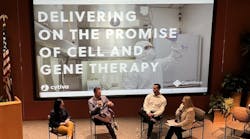Dr. Johannes Rauschnabel, Chief Pharma Expert at Bosch Packaging Technology
New legislation, expiring patents and increasing healthcare costs call for decisive changes in the global pharmaceutical industry. New markets for specialty medicines, biopharmaceuticals and biosimilars are opening up, entailing opportunities for further growth. The coming years will see markets across the globe implement new best practices and manufacturing concepts. What they all have in common is the need for safe, high-quality and consistent operations.A TRILLION HERE, A TRILLION THERE
According to a recent report by the IMS Institute of Healthcare Informatics¹, total annual spending on medicines is set to reach the $1 trillion threshold in 2014 and continue to rise to $1.2 trillion in 2017. After a period of turmoil due to patent expiries and austerity measures following the economic crisis, the developed markets are now starting to rebound. The U.S. is forecasted to resume increased spending following implementation of the Affordable Care Act. In Japan, the threat of rapidly increasing medical demands from the aging population urged the government to an unprecedented decision – by 2018, 60 percent of all off-patent prescription drugs are to be dispensed as generics. Overall, lower-cost generic alternatives will continue to have the largest impact on growth. Generic producers and contract manufacturers require very robust and flexible machinery with high output, while complex medicines for targeted treatment demand flexible platforms and smaller batch sizes.
The pharmerging markets will still be extending their progress by 10 to 13 percent, as population increases and rising incomes contribute to dramatically higher use of medicines. Improved access to drugs is supported by economic expansion, significant demographic and epidemiologic changes, and a broad range of government and private healthcare policies. China, the primary growth driver in Asia and beyond to date, now also faces a period of modest decline compared to recent years². This will not only affect local manufacturers but also pharmaceutical producers from the developed countries, who have built a large manufacturing and distribution network in China and have been rewarded with unparalleled revenues. India’s healthcare sector, on the other hand, does not seem to stop growing. Pharmaceutical exports from India are forecasted to increase more than twofold³ over the next four years, if India succeeds in meeting regulatory challenges.
REQUIRING FLEXIBILITY AND SAFETY
Robust and powerful machines remain the first choice for manufacturing companies in the emerging markets. Generic producers especially want to achieve the highest possible productivity at lowest possible costs. Many drug manufacturers have shifted their focus to the development of new drug formulations and have outsourced their end production such as filling and closing operations and secondary packaging to contract manufacturers. Their main concerns are flexibility and productivity – primary and secondary packaging machines must be adaptable to different products, packaging formats and speeds at consistently high output rates.
Although large-scale production of blockbuster products and generics is still the most prominent manufacturing assignment of the emerging markets, some countries like India also observe a shift to more complex formulations, which has led to a higher demand for sophisticated technologies. The trend towards small amounts of targeted drugs, particularly for the treatment of cancer, calls for flexible platforms that can handle small batches while ensuring the highest safety for both operators and products. Biopharmaceuticals, vaccines and anti-virals must be manufactured and packaged with the utmost caution and attention-to-detail.
BIOPHARMA’S PATENT CLIFF LOOMING
Having left the largest part of the generic patent cliff behind, the pharmaceutical industry now faces a new challenge. The patents of several large, biotech molecules are about to expire, opening the doors for biosimilar production. In 2002, biologics represented 11 percent of total drug sales; now IMS estimates biologic agents will continue to outpace overall pharma spending and will represent close to 20 percent of the total market value by 2017. Monoclonal antibodies and human insulin will further spur this growth. Biosimilars account for less than 0.5 percent of biologic spending in mature markets; in emerging markets, non-original biologics represent more than 10 percent of all biologics spending, and counting.
Biopharmaceuticals and their successors all require intensive research and development, as well as sophisticated equipment and contamination-free raw materials, such as Purified and Highly Purified Water and Water for Injection, generated by sophisticated high purity media systems. To deliver the best possible product to patients, drug manufacturers count on safe processing and packaging solutions, while patients rely on their preferred drug delivery devices for safe administration.
As far as these devices are concerned, the pharmaceutical industry has successfully focused its development activities on even safer and easier administration. Although oral dosage forms are more convenient, parenteral administration has taken its place as the most effective and safe treatment. For many biological products there is yet no alternative to parenteral administration. The development of new drug delivery devices increasingly focuses on patients’ individual needs4. Insulin pens, for example, have been optimized with respect to convenience and ease of use, while the devices generally tend to be smaller and safer to handle.
ISOLATING THE PRODUCT FROM THE OPERATOR
The use of high-potency pharmaceuticals has grown extensively, causing manufacturers to pay more heed to protecting all elements of the supply chain from their potentially harmful effects. Protecting products from contact with operators and vice versa has steadily moved up the agenda. Recent equipment solutions favor the use of automation and robotics technology to reduce human contact with the product. Due to ever-stricter guidelines for aseptic filling operations, manufacturers increasingly rely on the use of isolators. Compared to conventional cleanroom production, isolators offer higher product quality, lower operating costs and significant energy savings5, as well as a safe accomplishment of longer production cycles.
The U.S. Food and Drug Administration’s (FDA) 2004 aseptic guidance states that an isolator “offers tangible advantages over traditional aseptic processing, including fewer opportunities for microbial contamination during processing6.” The worldwide increase in filling line isolators will continue over the coming years7. Vials remain the predominant containers handled in isolators, while the use of pre-filled syringes is rapidly growing especially in Europe8.The development of ready-to-fill sterile primary packaging systems9 in cooperation with leading equipment manufacturers has improved aseptic filling operations and paved the way for the development of new, highly flexible filling and closing machines designed to handle pre-sterilized nested syringes, vials and cartridges.
CONTINUOUSLY CONTAINING HIGHLY POTENT SUBSTANCES
In parallel to the aseptic filling of liquid pharmaceuticals, manufacturers of solid dosage forms have also recognized the need for containment solutions. They prevent biological agents from escaping either into the working surroundings or the external environment, thus protecting operators from potent pharmaceutical compounds. Containment systems require closed containers or biological cabinets, and the use of rooms with specially designed air handling and secure operating procedures. Some drug manufacturers have already built entire containment facilities, where building and equipment are optimally fine-tuned to one another10. Involving the equipment supplier at an early planning stage ensures flexible, modular and space-saving solutions.
A concept that greatly benefits this approach is continuous processing. Adopted many years ago by other industries like food and chemicals, the pharmaceutical industry only recently started to apprehend the benefits in terms of cost, time, space and material savings. As opposed to batch manufacturing, continuous processing implies manufacturing and processing materials without interruption. This concept will only work if it is based on a thorough understanding of the process interaction between the different unit operations. As Dr. Janet Woodcock, Director of CDER (Center for Drug Evaluation and Research) at FDA, pointed out at the AAPS annual meeting in 2011, “Right now, manufacturing experts from the 1950s would easily recognize the pharmaceutical manufacturing processes of today."11 Yet the climate has changed in recent years, and leading manufacturers are developing new technologies which focus on reduced costs and improved efficiency.
BUILDING QUALITY INTO PRODUCTS
The FDA strongly advocates continuous processing and has pointed out frequently that the approach is consistent with the agency’s Quality by Design (QbD) efforts. QbD is “a science- and risk-based approach to pharmaceutical development and manufacturing […] to help ensure product quality."12 It aims at defining the quality and efficiency of a product before it is manufactured. Based on these requirements, product quality can be measured and controlled at different stages during the manufacturing process, while taking into account the impact of product and process properties on the final product. With a comprehensive control strategy for material, process and end product, QbD leads to reduced product loss, less production fluctuations and faster time-to-market. The QbD concept is also starting to be applied to biological products such as vaccines. However, the approach for solid formulations cannot simply be transferred to biological products. It still requires more experience and examples to establish suitable review and inspection paradigms.13
Process Analytical Technology (PAT14), “a system for designing, analyzing, and controlling manufacturing through timely measurement of critical quality and performance attributes of raw and in-process materials and processes, with the goal of ensuring final product quality”, is considered an integral part of QbD. When the FDA issued its PAT guidance in 2004, it triggered the development of entirely new technologies for the in-line elimination of variable product quality. Novel inspection devices, for instance for capsules, simultaneously inspect all quality features like weight, foreign particles and length in real-time and at high throughput rates. On-line checkweighers ensure in-process weight control and deliver exact weights to the filling system for adjustment of fill parameters. Software development and new imaging capabilities further contribute to a rapid advance of these technologies.
SERIALIZING, AGGREGATING AND AUTHENTICATING
Once all products have been safely manufactured, filled and inspected, they require one further step before they are brought on the market. Secondary packaging and end-of-line equipment plays a major role in ensuring pharmaceutical safety. Growing Internet sales volumes, production outsourcing and more complexsupply chains unfortunately provide numerous opportunities for counterfeit pharmaceuticals to enter the market. Many countries are currently developing and implementing new guidance and legislation to secure pharmaceutical products along the supply chain, for instance China, Argentina and Brazil, whose health surveillance agency ANVISA15 adopted a new resolution in December 2013.
The “Drug Quality and Security Act"16 qualifies the FDA to implement a standard numerical identification (SNI) code for the packaging of all prescription drugs in a step-by-step approach beginning in 2015. The Turkish Pharmaceutical Track & Trace System17 (ITS) even mandates the serialization of all OTC (over-the-counter) and prescription drugs on a unit level from production to patient. The European Union’s Directive 2011/62/EU18 (Falsified Medicines Directive) also stipulates the implementation of uniquely coded, serialized packs for almost all prescription drugs. At the same time, the EU demands a second layer of security – tamper-proof closures. They clearly indicate whether a package has been previously opened or tampered with.
Pharmaceutical manufacturers are facing enormous challenges to implement the respective regulations within the given timeframe. They must establish new procedures for the management and storage of serial numbers, which in turn requires the adaptation of highly sophisticated packaging processes in-line with global strategies. This calls for a sophisticated software architecture, which is able to integrate the serial numbers consistently on all levels – from devices, line processes and line management to production and enterprise control. A multi-layer and modular machine and software concept is obviously the safest option. It must be compatible with existing line concepts, allowing for the development of a complete system that complies with the industry’s demand for safe, high-quality and consistent operations.
ABOUT THE AUTHOR
Johannes Rauschnabel, PhD, is Chief Pharma Expert at Bosch Packaging Technology. He is a graduated Chemist from Eberhard-Karls-UniversityTuebingen andhas more than 25years experience in research and development and 15 years in the pharmaceutical industry as a product manager for Barrier Systems and as Director Process Engineering. Johannes Rauschnabelis a frequent speaker at conferences, a lecturer at University of Hohenheim and an author of multiple scientific papers and patents. Contact Dr. Johannes Rauschnabel







